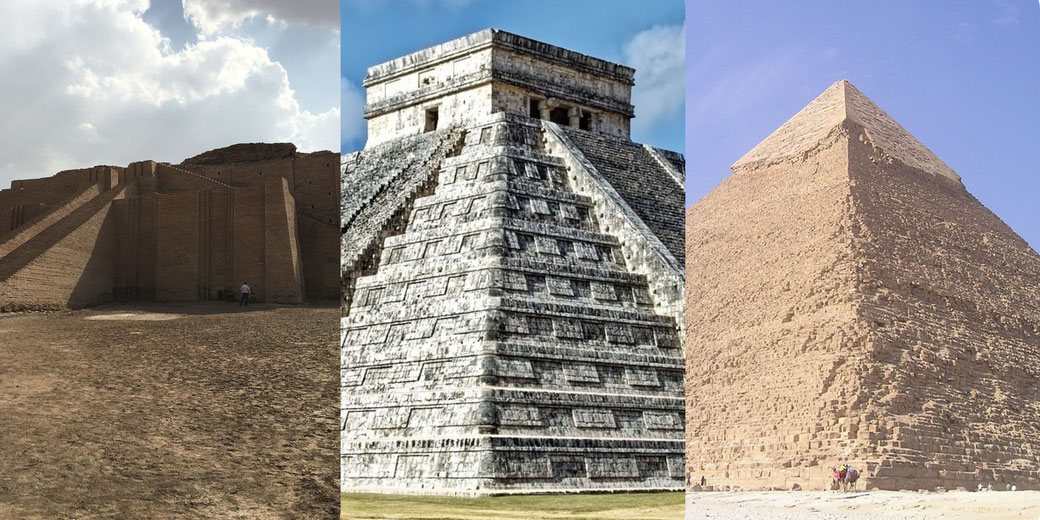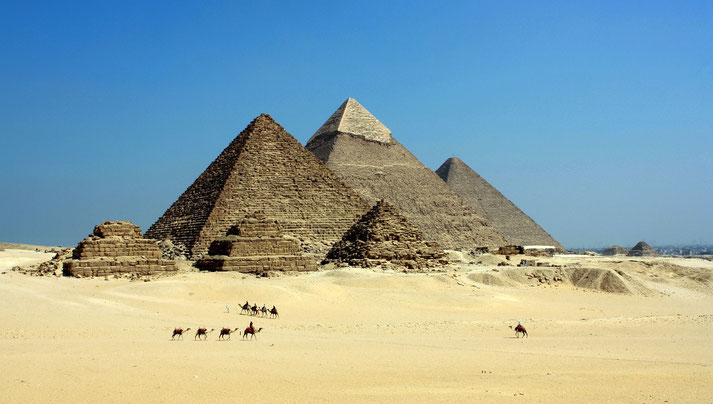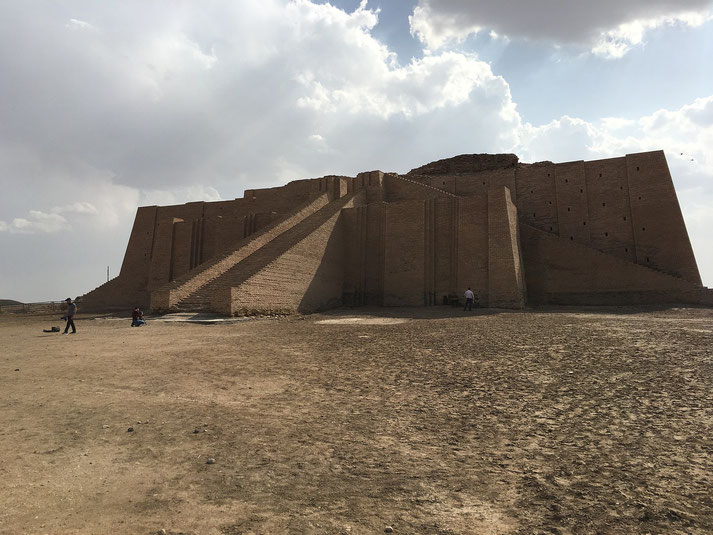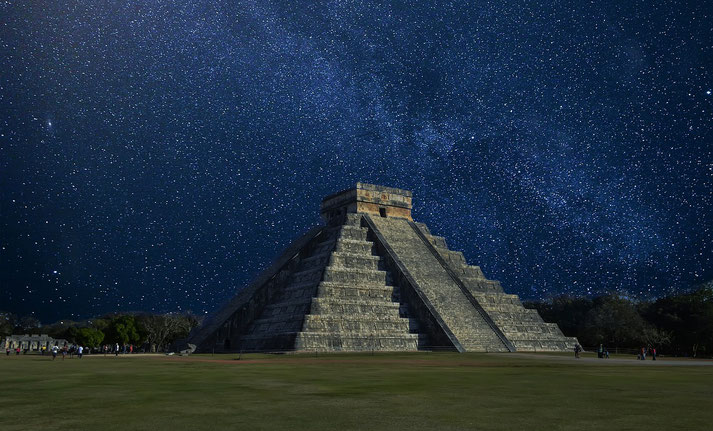The mysterious reason why pyramids appear in so many ancient cultures around the world

The outline of a pyramid that stands clearly against the horizon is surprisingly common and appears in many cultures throughout human history: from the sun-drenched sands of Egypt to the dense jungles of Mesoamerica.
Why did cultures separated by wide stretches of ocean and time all choose this distinctive building shape?
What is a 'pyramid'?
In its most basic architectural sense, a pyramid is a large structure with a polygonal base, usually square, and sloping sides that meet at a point.
While the classic image of a pyramid might be smooth-faced, some pyramids built in ancient Mesopotamia or Mesoamerica were stepped, rising in a series of terraces to the summit.
Others, such as the Nubian pyramids, have a much steeper incline and a smaller base than their Egyptian counterparts.
Still, other pyramids have flat tops, while others end in a small temple.
Regardless of these differences, the defining feature of all pyramid structures is the geometric shape that inspired their name.
Pyramids from different cultures and periods also share certain practical and symbolic characteristics.
To begin with, they are often built as tombs for rulers, temples for gods or centres for ritual and ceremony.
These shared roles all have a common view of pyramids as connecting the human world with the divine, and suggest that their towering heights function as bridges between humans and heaven.
Secondly, constructing pyramids typically requires enormous resources, drawing upon the wealth and power of the individuals or societies responsible for their creation.
The pyramids of Egypt
When the word 'pyramid' is mentioned, the first image that springs to mind for most people is likely the impressive pyramids of ancient Egypt.
Such pyramids were chiefly built between 2700 and 1700 BCE during the Old and Middle Kingdom periods.
However, the development of Egyptian pyramid construction developed over time.
The earliest form, the Step Pyramid of Djoser at Saqqara, which was built around 2700 BCE under the direction of the famous architect Imhotep, represented a major change from the usual mastaba tombs of the time.
It was made up of six terraces stacked atop one another and was the first huge stone building in Egypt.
Next, the Bent Pyramid of Pharaoh Sneferu was the first attempt at a smooth-sided pyramid but has a change of angle partway up, which gives it the bent appearance.
Eventually, builders reached the true pyramid shape with the Red Pyramid, constructed under Sneferu. It finally had unbroken, smooth sides.
The peak of this architectural evolution is undoubtedly the Great Pyramid of Giza, built for Pharaoh Khufu around 2580 to 2560 BCE.
As the largest of the three Giza pyramids, it remained the tallest structure created by humans for thousands of years, and was even one of the Seven Wonders of the Ancient World.
The accuracy and skill involved in its construction continue to amaze modern engineers and archaeologists.

The main purpose of Egyptian pyramids was as tombs for pharaohs and their consorts, but were also part of larger groups of buildings that included mortuary temples, smaller secondary pyramids, and other structures required for funeral rituals.
On a religious level, these pyramids represented the original mound of creation in Egyptian mythology, and, as such, they were believed to help the dead pharaoh in his rise to the afterlife.
Despite popular wrong ideas about the use of slaves, scholars generally agree that the pyramids were built by a 20,000-strong group of paid laborers and expert builders.
The ziggurats of Mesopotamia
Ziggurats emerged around the third millennium BCE in regions corresponding to modern-day Iraq and parts of Iran, Syria and Turkey.
These stepped pyramids are often at the heart of Mesopotamian cities.
Unlike the stone used for Egyptian pyramids, ziggurats are primarily built from mud-brick, a local resource that results in fewer surviving examples because mud-brick is less durable than stone.

Architecturally, ziggurats are terraced, with each level smaller than the one below, which creates a stepped appearance.
They usually feature broad staircases or ramps ascending to the top level where a shrine or temple sits.
The people believed that the gods descended to the temple at the summit to meet with priests and priestesses.
One of the best-preserved examples, the Great Ziggurat of Ur, was constructed during the reign of Ur-Nammu in the twenty-first century BCE.
This massive structure is over 30 metres (approximately 98 feet) high and is a part of a temple complex dedicated to the moon god Nanna.
The step-pyramids of the Americas
The pyramids of the Americas, built by civilizations including the Maya, Aztec, and Inca, as well as the ancient mound-builders of North America, stretched from the northern parts of North America down to the southern tip of South America.
In Mesoamerica, civilizations such as the Maya, in the region covering modern-day Mexico, Belize, Guatemala, and Honduras, built their own impressive stepped pyramids.
Famous examples include the Pyramid of the Magician at Uxmal and the Temple of the Inscriptions at Palenque, the latter of which was both a temple and the tomb of the ruler Pakal the Great.
The Aztec civilization in the Valley of Mexico built remarkable pyramids such as the Templo Mayor in their capital of Tenochtitlán: a double-staircase pyramid dedicated to the gods Tlaloc and Huitzilopochtli.
It featured two staircases leading to a shrine for one of the two gods.
However, North America has its own history of pyramid-like structures, particularly in the form of earthworks, which were built by the Mississippian culture.
A huge structure built of layers of earth, Monks Mound at Cahokia in modern-day Illinois, is the largest pre-Columbian earthwork in the Americas.

Further south, in the Andean region of South America, early societies such as the Moche, living along the northern coast of modern-day Peru, built using large adobe brick platforms, the most famous being Huaca del Sol (Temple of the Sun).
However, unlike the mainly funeral purpose of Egyptian pyramids, the pyramids of the Americas often had a more varied range of purposes, including as temples, palaces, and government buildings.
And even Nubia, Rome, and China...
While the pyramids of Egypt, Mesopotamia and the Americas are among the most well-known, these impressive structures can be found in other parts of the world as well.
In the region of ancient Nubia, now modern Sudan, a civilisation contemporary with ancient Egypt constructed its own style of pyramids.
The Nubian pyramids that were built between circa 800 BCE and 300 CE were generally smaller and steeper than their Egyptian counterparts.
These pyramids, which were primarily tombs for the rulers of the kingdoms of Kush and Meroë, showed a unique blend of Egyptian and local Nubian architectural styles.
While less famous than their Egyptian counterparts, over two hundred Nubian pyramids still stand today.
Also, ancient Greece and Rome practised pyramid construction, albeit on a much smaller scale.
For example, the Pyramid of Cestius in Rome, which was built between 18 and 12 BCE, was the tomb for the magistrate Gaius Cestius.
Regarding China, in ancient times there existed structures often referred to as 'pyramids', though they differ significantly from the pyramidal form seen in Egypt or Mesoamerica.
Many imperial tombs from the Qin Dynasty onward were built as massive earthen mounds.
The most famous is the mausoleum of the First Qin Emperor, constructed circa 246 to 208 BCE, which is known for its army of Terracotta Warriors.
Later tombs from the Han Dynasty (206 BCE to 220 CE) through the Tang Dynasty (618 CE to 907 CE) continued this tradition of monumental earthen burial mounds.
Why did this architecture appear in so many places?
Although there is no agreement on why this particular form of architecture appears so often in ancient civilisations, several theories have been proposed.
One theory is based upon the structural stability of the pyramid shape. The wide base and narrowing top provide a stable structure that can stand the test of time.
Remarkable durability is evident from the fact that many ancient pyramids remain standing thousands of years after their construction, even after other types of structures have fallen.
A second theory relates to the symbolic importance of the pyramid shape. Many ancient cultures linked the shape of the pyramid with spiritual or celestial ideas.
Like the example used before in Mesoamerica, pyramids were seen as man-made mountains that connected the earthly realm with the divine.
The shape of the pyramid could have been chosen for its strong symbolic impact, and it gave a physical form to these cultures' beliefs about the universe.
It is also worth noting the theory of independent invention: the suggestion that the pyramid form arose independently in different cultures due to similar circumstances, needs or influences.
Although some have suggested ideas of trans-oceanic contact between these cultures, there is no widely accepted archaeological evidence to support such claims.
Such theories are not mutually exclusive, and a combination of these factors likely contributed to the prevalence of pyramid structures in different cultures.
Evidence of extraterrestrial contact?
The theory that extraterrestrial beings visited Earth in ancient times and helped build monumental structures like pyramids is a popular topic in pseudoscience and popular culture.
Supporters of these 'ancient astronaut' theories often point to the impressive architectural feats of ancient civilisations and argue that they must have needed advanced knowledge or technology beyond what those societies could have had.
However, there is no scientifically accepted evidence to support these theories.
Archaeologists, historians and scientists generally agree that the pyramids and other monumental structures of the ancient world were built by human societies using the tools, techniques and knowledge available to them at the time.
Although it is true that many aspects of these structures are impressive and that scholars do not fully understand all the techniques used in their construction, this does not mean that extraterrestrials were involved.
In fact, many of the supposed 'mysteries' about pyramid construction are the subject of ongoing research, and scholars have made significant progress in understanding how ancient technology could have been used to build these remarkable buildings.
What do you need help with?
Download ready-to-use digital learning resources
Copyright © History Skills 2014-2025.
Contact via email
With the exception of links to external sites, some historical sources and extracts from specific publications, all content on this website is copyrighted by History Skills. This content may not be copied, republished or redistributed without written permission from the website creator. Please use the Contact page to obtain relevant permission.





